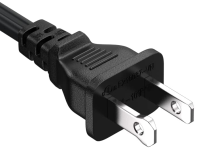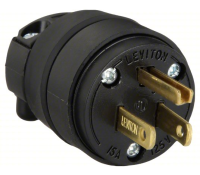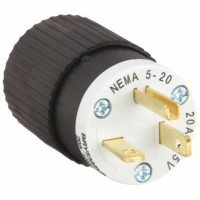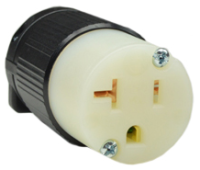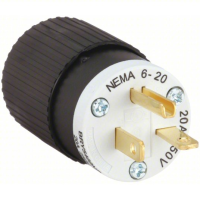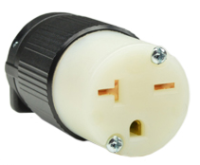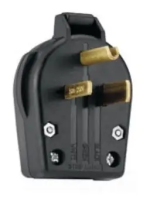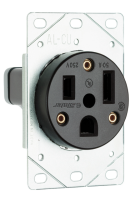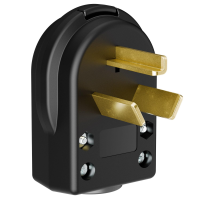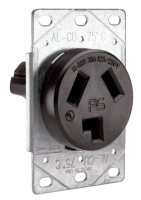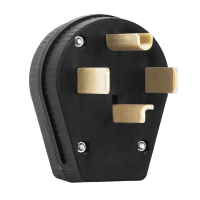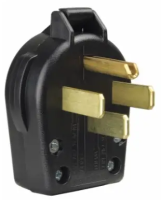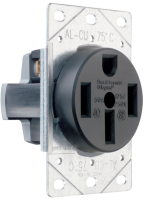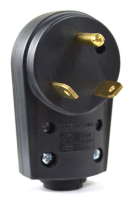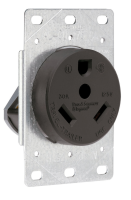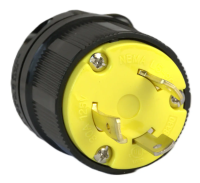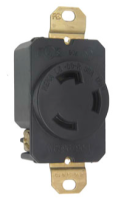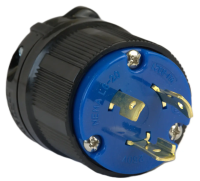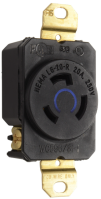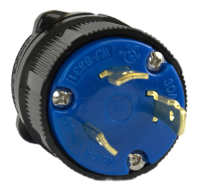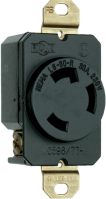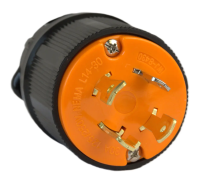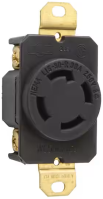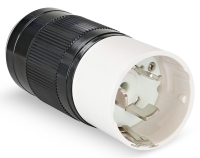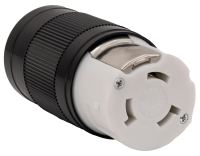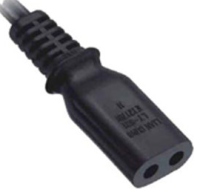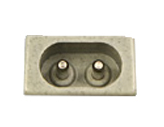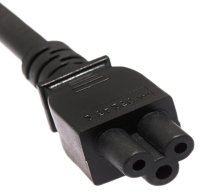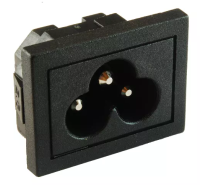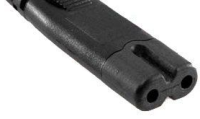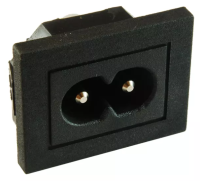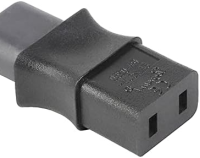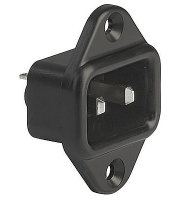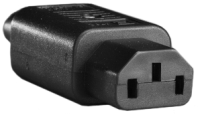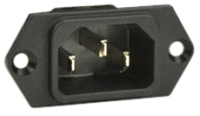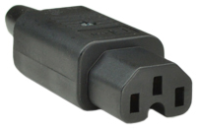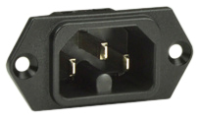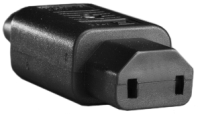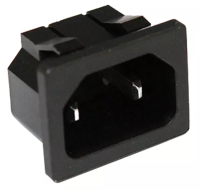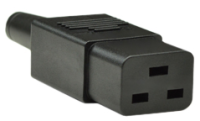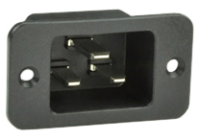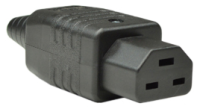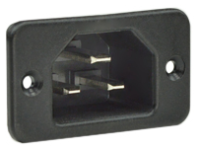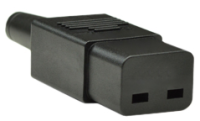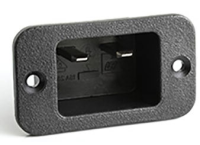Electrical Connectors: Difference between revisions
No edit summary |
|||
| (20 intermediate revisions by the same user not shown) | |||
| Line 5: | Line 5: | ||
NEMA (National Electrical Manufacturers Association) connectors are the standard power plugs and receptacles used throughout North America. They are defined by a coded system that specifies voltage, current rating, grounding method, and configuration, with common household types such as NEMA 5-15 for 120 V and heavier-duty options like NEMA 14-50 for high-power appliances or EV charging. NEMA designs include both straight-blade and locking (twist-lock) styles to prevent accidental disconnection in industrial or outdoor settings. Their robust construction and clear labeling make them a reliable choice for residential, commercial, and industrial electrical installations. | NEMA (National Electrical Manufacturers Association) connectors are the standard power plugs and receptacles used throughout North America. They are defined by a coded system that specifies voltage, current rating, grounding method, and configuration, with common household types such as NEMA 5-15 for 120 V and heavier-duty options like NEMA 14-50 for high-power appliances or EV charging. NEMA designs include both straight-blade and locking (twist-lock) styles to prevent accidental disconnection in industrial or outdoor settings. Their robust construction and clear labeling make them a reliable choice for residential, commercial, and industrial electrical installations. | ||
{{Info| This is a list of only the most common NEMA connectors. For a more comprehensive list, check out [https://en.wikipedia.org/wiki/NEMA_connector https://en.wikipedia.org/wiki/NEMA_connector]}} | |||
{{Info|Suffixes denote gender: P = Plug (male), R = Receptacle (female). E.g., 1-15P, 14-50R}} | |||
==Straight-blade== | ==Straight-blade== | ||
| Line 17: | Line 19: | ||
!Typical Uses | !Typical Uses | ||
|- | |- | ||
| 5-15 || [[File:N5-15P.png| | | 1-15 || [[File:N1-15P.png|center|200x200px|thumb|left]] || [[File:N1-15R.png|center|200x200px|thumb|left]] || 125 || 15 || Household (receptacle deprecated) | ||
|- | |||
| 5-15 || [[File:N5-15P.png|center|200x200px|thumb|left]] || [[File:N5-15R.png|center|200x200px|thumb|left]] || 125 || 15 || Household | |||
|- | |||
| 5-20 || [[File:N5-20P.png|center|200x200px|thumb|left]] || [[File:N5-20R.png|center|200x200px|thumb|left]] || 125 || 20 || Household/Commercial high-current | |||
|- | |- | ||
| | | 6-20 || [[File:N6-20P.png|center|200x200px|thumb|left]] || [[File:N6-20R.png|center|200x200px|thumb|left]] || 250 || 20 || Air compressors, wall air conditioners | ||
|- | |- | ||
| 6-50 || [[File:N6-50P.png| | | 6-50 || [[File:N6-50P.png|center|200x200px|thumb|left]] || [[File:N6-50R.png|center|200x200px|thumb|left]] || 250 || 20 || Welders, commercial kitchen equipment | ||
|- | |- | ||
| 10-30 || [[File:N10-30P.png| | | 10-30 || [[File:N10-30P.png|center|200x200px|thumb|left]] || [[File:N10-30R.png|center|200x200px|thumb|left]] || 125/250 || 30 || Clothes dryers, kitchen ranges (deprecated) | ||
|- | |- | ||
| 14-30 || [[File:N14-30P.png| | | 14-30 || [[File:N14-30P.png|center|200x200px|thumb|left]] || [[File:N14-30R.png|center|200x200px|thumb|left]] || 125/250 || 30 || Clothes dryers, kitchen ranges, EV charging | ||
|- | |- | ||
| 14-50 || [[File:N14-50P.png| | | 14-50 || [[File:N14-50P.png|center|200x200px|thumb|left]] || [[File:N14-50R.png|center|200x200px|thumb|left]] || 125/250 || 50 || Clothes dryers, kitchen ranges, EV charging | ||
|- | |- | ||
| TT-30 || [[File:TT-30P.png| | | TT-30 || [[File:TT-30P.png|center|200x200px|thumb|left]] || [[File:TT-30R.png|center|200x200px|thumb|left]] || 125 || 30 || Travel Trailer (RV/Campers) | ||
|} | |} | ||
| Line 42: | Line 48: | ||
!Typical Uses | !Typical Uses | ||
|- | |- | ||
| L5-30 || [[File:L5-30P.png| | | L5-30 || [[File:L5-30P.png|center|200x200px|thumb|left]] || [[File:L5-30R.png|center|200x200px|thumb|left]] || 125 || 30 || Marine, RV/Camper | ||
|- | |- | ||
| L6-20 || [[File:L6-20P.png| | | L6-20 || [[File:L6-20P.png|center|200x200px|thumb|left]] || [[File:L6-20R.png|center|200x200px|thumb|left]] || 250 || 20 || Information technology (servers, PDUs, etc) | ||
|- | |- | ||
| L6-30 || [[File:L6-30P.png| | | L6-30 || [[File:L6-30P.png|center|200x200px|thumb|left]] || [[File:L6-30R.png|center|200x200px|thumb|left]] || 250 || 30 || Welders, industrial equipment | ||
|- | |- | ||
| L14-30 || [[File:L14-30P.png| | | L14-30 || [[File:L14-30P.png|center|200x200px|thumb|left]] || [[File:L14-30R.png|center|200x200px|thumb|left]] || 250 || 30 || Portable generators, large audio systems | ||
|- | |- | ||
| SS2-50 || [[File:SS2-50P.png| | | SS2-50 || [[File:SS2-50P.png|center|200x200px|thumb|left]] || [[File:SS2-50R.png|center|200x200px|thumb|left]] || 250 || 50 || Ship-to-shore (marine), portable generators | ||
|} | |} | ||
| Line 57: | Line 63: | ||
IEC (International Electrotechnical Commission) connectors are globally standardized plugs and couplers designed to provide safe, interchangeable power connections across different countries and devices. The most familiar is the IEC 60320 family, used on computer and appliance power cords, where lettered types such as C13/C14 or C19/C20 indicate temperature rating and current capacity. IEC standards also cover industrial power connectors (IEC 60309) with color-coded housings to denote voltage and frequency, ensuring international compatibility. These connectors emphasize interoperability and safety, enabling equipment manufacturers and users to rely on a single set of specifications worldwide. | IEC (International Electrotechnical Commission) connectors are globally standardized plugs and couplers designed to provide safe, interchangeable power connections across different countries and devices. The most familiar is the IEC 60320 family, used on computer and appliance power cords, where lettered types such as C13/C14 or C19/C20 indicate temperature rating and current capacity. IEC standards also cover industrial power connectors (IEC 60309) with color-coded housings to denote voltage and frequency, ensuring international compatibility. These connectors emphasize interoperability and safety, enabling equipment manufacturers and users to rely on a single set of specifications worldwide. | ||
{{Info|All below connected are rated up to 250V AC.}} | |||
{{Info|Parity denotes gender: Odd = Plug (male), Even = Receptacle (female)}} | |||
{| class=wikitable | {| class=wikitable | ||
!Connector | |||
!Plug | !Plug | ||
!Receptacle | !Receptacle | ||
!Amps (A) | !Amps (A) | ||
!Typical Uses | !Typical Uses | ||
|- | |- | ||
| C1 | | C1/C2 || [[File:C1.png|center|200x200px|thumb|left]] || [[File:C2.png|center|200x200px|thumb|left]] || 0.2 || Electric shavers, small appliances | ||
|- | |- | ||
| | | C5/C6 || [[File:C5.png|center|200x200px|thumb|left]] || [[File:C6.png|center|200x200px|thumb|left]] || 2.5 || Laptop power supplies | ||
|- | |- | ||
| | | C7/C8 || [[File:C7.png|center|200x200px|thumb|left]] || [[File:C8.png|center|200x200px|thumb|left]] || 2.5 || Household audio/video equipment | ||
|- | |- | ||
| | | C9/C10 || [[File:C9.png|center|200x200px|thumb|left]] || [[File:C10.png|center|200x200px|thumb|left]] || 6 || Audio equipment | ||
|- | |- | ||
| C13 || C13 || [[File: | | C13/C14 || [[File:C13.png|center|200x200px|thumb|left]] || [[File:C14.png|center|200x200px|thumb|left]] || 10 || Computer, enterprise IT | ||
|- | |- | ||
| C15 || | | C15/C16 || [[File:C15.png|center|200x200px|thumb|left]] || [[File:C16.png|center|200x200px|thumb|left]] || 10 || Kettles, enterprise IT | ||
|- | |- | ||
| C17 || | | C17/C18 || [[File:C17.png|center|200x200px|thumb|left]] || [[File:C18.png|center|200x200px|thumb|left]] || 10 || Small household electronics | ||
|- | |- | ||
| C19 || | | C19/C20 || [[File:C19.png|center|200x200px|thumb|left]] || [[File:C20.png|center|200x200px|thumb|left]] || 16 || Enterprise IT, servers, UPS's, PDU's | ||
|- | |- | ||
| C21 || | | C21/C22 || [[File:C21.png|center|200x200px|thumb|left]] || [[File:C22.png|center|200x200px|thumb|left]] || 16 || High-temperature variant of C19 | ||
|- | |- | ||
| C23 || | | C23/C24 || [[File:C23.png|center|200x200px|thumb|left]] || [[File:C24.png|center|200x200px|thumb|left]] || 16 || Ungrounded variant of C19 | ||
|} | |} | ||
Latest revision as of 19:23, 15 September 2025
The National Electrical Manufacturers Association (NEMA) and the International Electrotechnical Commission (IEC) are two major organizations that define standards for electrical connectors used worldwide. NEMA connectors are primarily used in North America and feature a variety of locking and non-locking configurations designed for specific voltage and amperage ratings, making them common in residential, commercial, and industrial settings. IEC connectors, on the other hand, provide internationally recognized standards that promote compatibility across different countries and devices, such as the widely used IEC 60320 couplers for power cords on appliances and electronics. While both systems aim to ensure safety, reliability, and interoperability, their designs and naming conventions differ, requiring adapters or region-specific equipment when crossing markets.
NEMA Connectors
NEMA (National Electrical Manufacturers Association) connectors are the standard power plugs and receptacles used throughout North America. They are defined by a coded system that specifies voltage, current rating, grounding method, and configuration, with common household types such as NEMA 5-15 for 120 V and heavier-duty options like NEMA 14-50 for high-power appliances or EV charging. NEMA designs include both straight-blade and locking (twist-lock) styles to prevent accidental disconnection in industrial or outdoor settings. Their robust construction and clear labeling make them a reliable choice for residential, commercial, and industrial electrical installations.
![]() Info: This is a list of only the most common NEMA connectors. For a more comprehensive list, check out https://en.wikipedia.org/wiki/NEMA_connector
Info: This is a list of only the most common NEMA connectors. For a more comprehensive list, check out https://en.wikipedia.org/wiki/NEMA_connector
![]() Info: Suffixes denote gender: P = Plug (male), R = Receptacle (female). E.g., 1-15P, 14-50R
Info: Suffixes denote gender: P = Plug (male), R = Receptacle (female). E.g., 1-15P, 14-50R
Straight-blade
Locking (twist-lock)
IEC
IEC (International Electrotechnical Commission) connectors are globally standardized plugs and couplers designed to provide safe, interchangeable power connections across different countries and devices. The most familiar is the IEC 60320 family, used on computer and appliance power cords, where lettered types such as C13/C14 or C19/C20 indicate temperature rating and current capacity. IEC standards also cover industrial power connectors (IEC 60309) with color-coded housings to denote voltage and frequency, ensuring international compatibility. These connectors emphasize interoperability and safety, enabling equipment manufacturers and users to rely on a single set of specifications worldwide.
![]() Info: All below connected are rated up to 250V AC.
Info: All below connected are rated up to 250V AC.
![]() Info: Parity denotes gender: Odd = Plug (male), Even = Receptacle (female)
Info: Parity denotes gender: Odd = Plug (male), Even = Receptacle (female)

